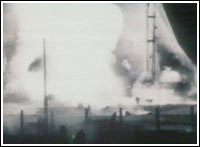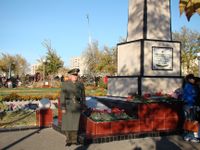كارثة ندلين
 The explosion | |
| الاسم المحلي | Катастрофа на космодроме Байконур |
|---|---|
| الاسم الإنگليزي | The Catastrophe at Baikonur Cosmodrome |
| التاريخ | 24 أكتوبر 1960 |
| الوقت | 18:45 |
| المكان | Baikonur Cosmodrome |
| الموقع | |
| ويُعرف أيضاً بـ | Nedelin disaster |
| النوع | Rocket explosion |
| السبب | Short circuit in the rocket |
| تنظيم | Soviet Strategic Missile Troops |
| الوفيات | 78 (92-126 from other sources) |
| اصابات غير قاتلة | 120 |
The Nedelin catastrophe or Nedelin disaster was a launch pad accident that occurred on 24 October 1960 at Baikonur test range (of which Baikonur Cosmodrome is a part), during the development of the Soviet ICBM R-16. As a prototype of the missile was being prepared for a test flight, an explosion occurred when the second stage engine ignited accidentally, killing an unknown number of military and technical personnel working on the preparations. Despite the magnitude of the disaster, news of it was suppressed for many years and the Soviet government did not acknowledge the event until 1989. The disaster is named after Chief Marshal of Artillery Mitrofan Ivanovich Nedelin, who was killed in the explosion. As commanding officer of the Soviet Union's Strategic Rocket Forces, Nedelin was head of the R-16 development program.
Launch preparations
On 23 October 1960, the prototype R-16 had been installed on launching pad 41 (روسية: стартовая позиция 41) awaiting final tests before launch. The missile was over 30 m long, 3.0 m in diameter and had a launch weight of 141 tons. The rocket was fueled with the hypergolic pair of UDMH as fuel and a saturated solution of dinitrogen tetroxide in nitric acid as the oxidizer — which was used because of the high boiling temperatures and hence storability of the fuel and oxidizer, despite being extremely corrosive and toxic. These risks were accounted for in the safety requirements of the launch procedures, but Nedelin's insistence on achieving a test launch ahead of the November 7 anniversary of the Bolshevik Revolution resulted in extreme schedule pressure, in a context of substantial emerging engineering difficulties.[1][2] Ultimately pre-launch tests began to overlap with launch preparations.[2]
Accident
A short circuit in the replaced main sequencer caused the second stage engine to fire while being tested before launch. This detonated the first stage fuel tanks directly below, destroying the missile in an enormous explosion. Before seeking refuge, the camera operator had remotely activated automatic cameras set around the launching pad that filmed the explosion in detail. People near the rocket were instantly incinerated; those farther away were burned to death or poisoned by the toxic fuel component vapors. Andrei Sakharov described many details—as soon as the engine fired, most of the personnel there ran to the perimeter, but were trapped inside the security fence and then engulfed in the fireball of burning fuel. The resultant explosion incinerated or asphyxiated Nedelin, a top aide, the USSR's top missile guidance designer, and over seventy other officers and engineers. Others died later of burns or poisoning.[3][2][4][1] Missile designer Mikhail Yangel and the test range commanding officer survived only because they had left to smoke a cigarette behind a bunker a few hundred meters away, but nonetheless suffered burn injuries.[3][5]
الأعقاب
Complete secrecy was immediately imposed on the events of 24 October by Nikita Khrushchev. A news release stated that Nedelin had died in a plane crash and the families of the other engineers were advised to say their loved ones had died of the same cause. Khrushchev also ordered Leonid Brezhnev to head an investigation commission and go to the site. Among other things, the commission found that many more people were present on the launch pad than should have been — most were supposed to be safely offsite in bunkers.[بحاجة لمصدر]
According to Sergei Khrushchev, Brezhnev insisted that the commission punish no one, explaining that "The guilty have already been punished."

See also
- Intelsat 708 - 1996 launch failure which killed 6 people, in the worst space launch disaster since Nedelin.
- 1980 Plesetsk launch pad disaster
- 1980 Damascus Titan missile explosion
ببليوجرافيا
- Khrushchev, Sergei. Nikita Khrushchev and the Creation of a Superpower. Pennsylvania State University Press, Pennsylvania, 2000. Translated by Shirley Benson. pp 416–425.
- Harford, James. Korolev – How One Man Masterminded the Soviet Drive to Beat America to the Moon. John Wiley & Sons, Inc., New York, 1997. pp 119–120. ISBN 0-471-14853-9
- Chertok, Boris. Missiles and People: Fili-Podlipki-Tyuratam. Moscow, Mashinostroyeniye Publishing House, 1996. (In Russian)
- Chertok, Boris. Rockets and People, Volume 2: Creating a Rocket Industry, 2006. Published by NASA. ISBN 0-16-076672-9
- Sheehan, Neil, A Fiery Peace in a Cold War, Random House, New York, 2009, p 405.
- "Testing of rocket and space technology - the business of my life" Events and facts - A.I. Ostashev, Korolyov, 2001.[1].
- "Baikonur. Korolev. Yangel." - M. I. Kuznetsk, Voronezh: IPF "Voronezh", 1997, ISBN 5-89981-117-X;
- "We grew hearts in Baikonur" - Author: Eliseev V. I. M: publisher OAO MPK in 2018, ISBN 978-5-8493-0415-1
References
- ^ أ ب Chapter 32 (Catastrophes), https://history.nasa.gov/SP-4110/vol2.pdf Boris Chertok (author). Rockets and People, Volume 2: Creating a Rocket Industry, 2006, ISBN 0-16-076672-9, Published by NASA
- ^ أ ب ت
Zak, Anatoly; et al. "Nedelin Disaster". Rockets: R16 family. Retrieved 17 Feb 2019.
{{cite web}}: Unknown parameter|deadurl=ignored (|url-status=suggested) (help) - ^ أ ب Steve Zaloga, The Kremlin's Nuclear Sword: The Rise and Fall of Russia's Strategic Nuclear Forces, 1945-2000 (Smithsonian Institution Press, 2002) pp 66-67
- ^
Yoon, Joseph N. (6 June 2004). "Nedelin Disaster". Spacecraft Questions. Retrieved 18 Feb 2019.
{{cite web}}: Unknown parameter|deadurl=ignored (|url-status=suggested) (help) - ^ Chris Gainor, Into that Silent Sea: Trailblazers of the Space Era, 1961-1965 (University of Nebraska Press, 2007) p180
وصلات خارجية
- Nedelin Disaster on RussianSpaceWeb.com
- Nedelin Disaster on aerospaceweb.org
- The Nedelin Catastrophe — article from Air & Space Magazine
- Video clip
- Day when not start missiles. Part one
- Day when not start missiles. Part two
- Memorial
- The newspaper Moskovsky Komsomolets // The disaster at Baikonur (بالروسية)
- The Russian Union Of Veterans // Day of memory and grief.(بالروسية)
- The official website of the city administration Baikonur // Baikonur commemorated a test rocket and space technology.(بالروسية)
- CS1 errors: unsupported parameter
- Pages using gadget WikiMiniAtlas
- Articles containing روسية-language text
- Pages using Lang-xx templates
- Articles with unsourced statements from March 2012
- Pages with empty portal template
- Coordinates on Wikidata
- Space accidents and incidents in the Soviet Union
- Non-combat military accidents
- برنامج فضاء الاتحاد السوڤيتي
- Soviet coverups
- كوارث في قزخستان
- قتلى برنامج الفضاء
- كوارث 1960
- 1960 في الاتحاد السوڤيتي
- Filmed accidental deaths
- Baikonur Cosmodrome
- كوارث في الاتحاد السوڤيتي